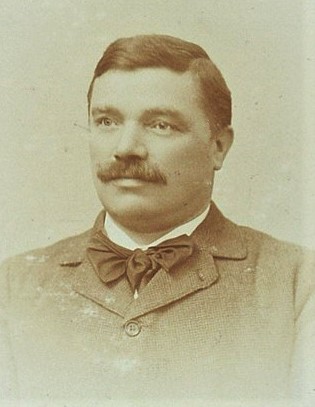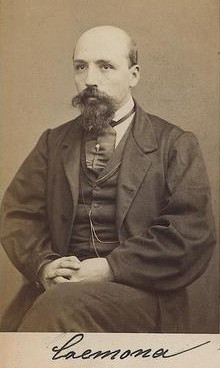In relation to the history of mathematics, the Italian school of algebraic geometry refers to mathematicians and their work in birational geometry, particularly on algebraic surfaces, centered around Rome roughly from 1885 to 1935. There were 30 to 40 leading mathematicians who made major contributions, about half of those being Italian. The leadership fell to the group in Rome of Guido Castelnuovo, Federigo Enriques and Francesco Severi, who were involved in some of the deepest discoveries, as well as setting the style.

Ulisse Dini was an Italian mathematician and politician, born in Pisa. He is known for his contributions to real analysis, partly collected in his book "Fondamenti per la teorica delle funzioni di variabili reali".

Luigi Bianchi was an Italian mathematician. He was born in Parma, Emilia-Romagna, and died in Pisa. He was a leading member of the vigorous geometric school which flourished in Italy during the later years of the 19th century and the early years of the twentieth century.

Guido Castelnuovo was an Italian mathematician. He is best known for his contributions to the field of algebraic geometry, though his contributions to the study of statistics and probability theory are also significant.

Francesco Severi was an Italian mathematician. He was the chair of the committee on Fields Medal in 1936, at the first delivery.

Antonio Luigi Gaudenzio Giuseppe Cremona was an Italian mathematician. His life was devoted to the study of geometry and reforming advanced mathematical teaching in Italy. He worked on algebraic curves and algebraic surfaces, particularly through his paper Introduzione ad una teoria geometrica delle curve piane, and was a founder of the Italian school of algebraic geometry.
In mathematics, the Enriques–Kodaira classification groups compact complex surfaces into ten classes, each parametrized by a moduli space. For most of the classes the moduli spaces are well understood, but for the class of surfaces of general type the moduli spaces seem too complicated to describe explicitly, though some components are known.
In mathematics, Enriques surfaces are algebraic surfaces such that the irregularity q = 0 and the canonical line bundle K is non-trivial but has trivial square. Enriques surfaces are all projective and are elliptic surfaces of genus 0. Over fields of characteristic not 2 they are quotients of K3 surfaces by a group of order 2 acting without fixed points and their theory is similar to that of algebraic K3 surfaces. Enriques surfaces were first studied in detail by Enriques as an answer to a question discussed by Castelnuovo (1895) about whether a surface with q = pg = 0 is necessarily rational, though some of the Reye congruences introduced earlier by Reye are also examples of Enriques surfaces.

Beniamino Segre was an Italian mathematician who is remembered today as a major contributor to algebraic geometry and one of the founders of finite geometry.

Francesco Giacomo Tricomi was an Italian mathematician famous for his studies on mixed type partial differential equations. He was also the author of a book on integral equations.

Enzo Martinelli was an Italian mathematician, working in the theory of functions of several complex variables: he is best known for his work on the theory of integral representations for holomorphic functions of several variables, notably for discovering the Bochner–Martinelli formula in 1938, and for his work in the theory of multi-dimensional residues.

Giovanni Battista Rizza, officially known as Giambattista Rizza, was an Italian mathematician, working in the fields of complex analysis of several variables and in differential geometry: he is known for his contribution to hypercomplex analysis, notably for extending Cauchy's integral theorem and Cauchy's integral formula to complex functions of a hypercomplex variable, the theory of pluriharmonic functions and for the introduction of the now called Rizza manifolds.
In algebraic geometry, a Castelnuovo curve, studied by Castelnuovo, is a curve in projective space Pn of maximal genus g among irreducible non-degenerate curves of given degree d.

Antonio Fais was an Italian mathematician and railway engineer. He was rector at the University of Cagliari from 1897 to 1898.
Gaspare Mignósi was an Italian mathematician.

Michele de Franchis was an Italian mathematician, specializing in algebraic geometry. He is known for the De Franchis theorem and the Castelnuovo–de Franchis theorem.
Giacomo Bellacchi (1838–1924) was an Italian mathematician.

Giuseppina Masotti Biggiogero was an Italian mathematician and historian. Known for her work in algebraic geometry, she also wrote noted histories of mathematicians, like Maria Gaetana Agnesi and Luca Pacioli. She was a member of the Lombard Institute Academy of Science and Letters and won both the Bordoni Prize and Torelli Prize for her work.
Laura Toti Rigatelli (1941-2023) was an Italian historian of mathematics, founder of the Center for Medieval Mathematics at the University of Siena, biographer of Évariste Galois, and author of many books on the history of mathematics.












